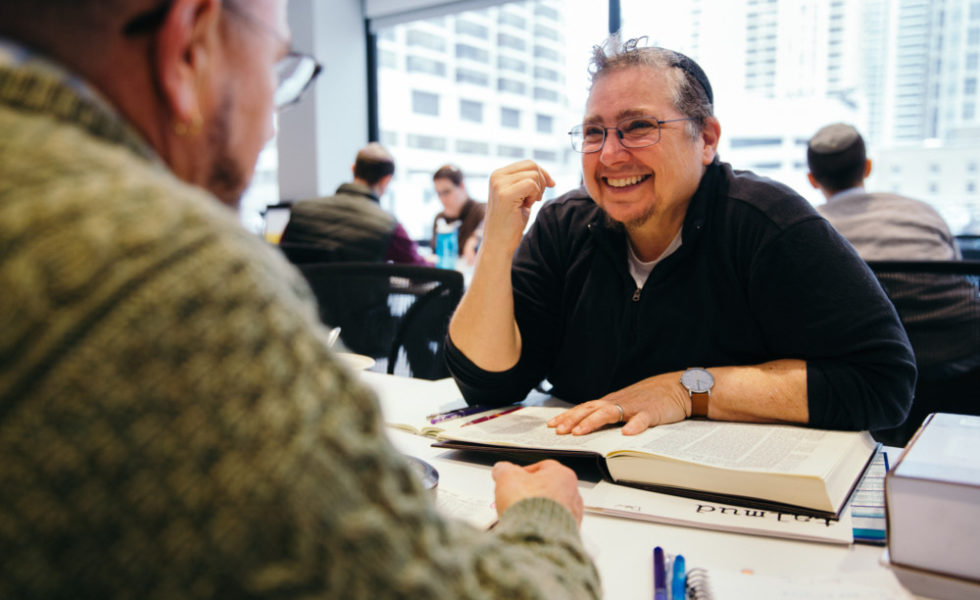The Power of Our Minhag

by Laynie Soloman, Associate Rosh Yeshiva
Last week, the Conservative movement’s halakhic decision-making team, the Committee on Jewish Laws and Standards (CJLS), approved a teshuva, a written responsum, that codified one pathway in Jewish practice for Jews to be called to the Torah using a non-binary liturgical structure. A teshuva is, in essence, much like a Jewish position paper that seeks to answer a question about the practical application of Jewish tradition. This teshuva, authored by Rabbis Guy Austrian, Robert Scheinberg, and Deborah Silver, responded to the question, “How should we honor non-binary individuals called to the Torah?”
This teshuva, and the process that lead to its creation and approval, was driven by minhag, “custom.” SVARA-niks will remember that minhag is one of the five sources from which new laws/practices can be innovated, according to Menachem Elon. Elon defines minhag as “a particular normative act, occurring constantly, and whose existence can be demonstrated without doubt” (Menachem Elon, “Minhag,” The Principles of Jewish Law, 91-92). Want to know what to do? Look around, puk hazi, go out and see what people are doing. This is an authentic source from which new practices are created. The root of minhag (מנהג), is נהג, which contains so many directional meanings, like, “to lead,” “to conduct,” and also “to be guided” or “to apply.” Perhaps through minhag, we simultaneously lead and are guided, shaping tradition and guiding each other.
As queer and trans folks, as feminists, as abolitionists, as people who are committed to surviving and thriving beyond existing power structures, we know that custom—the way people do stuff—is a powerful source of truth. There are often no guidebooks for the ways we are seeking to live, and so we create our minhagim together as we go. We gather insight by lifting up our elders, creating our own communities, and building our own practices. We know that these are all real and sacred steps in the process of figuring out what to do. What we do beyond and behind—and before—codification, in the interstitial moments of our lives and communities—all of that is minhag, and all of that is an authentic source of wisdom. Uplifting custom has always been a central part of feminist calls to reshape and retool a liberatory halakha that honors and takes seriously the wisdom of those on the margins.
Trans and non-binary people have been recreating ritual since the beginning of time. As trans Jews, we have called ourselves to the Torah, we have named ourselves, we have found new language for G!d and the transcendent moments that give shape to our lives. The minhagim (“customs”) that are in this teshuva include conventions attributed to Max Strassfeld (using “mi’beit” as a non-gendered naming convention in Hebrew names), San Francisco’s Congregation Sha’ar Zahav, and New York City’s CBST/Congregation Beit Simchat Torah (the convention of a non-gendered “na la’amod” invitation to stand when called to the Torah, along with gendered modifications for aliyot rather than people). These conventions have been practiced for decades by trans and non-binary folks who have then lovingly brought them to communities like those legislated by the CJLS.
The miracle of this teshuva, that was passed by the halakhic arm of the Conservative Movement, is not that it came into being, but rather the tremendous minhag that trans folks brought into being so that it could be written down. As one journalist said earlier this week: “Five years ago, Rabbi Guy Austrian made a small but powerful change at the synagogue he leads: He wrote down the language his community used to call non-binary members to the Torah.” Trans and non-binary folks were being called to honors—both honoring the Torah and ourselves—and R’ Guy Austrian, my rabbi and teacher, took the time to carefully and generously write it down. The rabbis who authored this teshuva, Rabbis Guy Austrian, Robert Scheinberg, and Deborah Silver, took seriously what had emerged among trans and non-binary folks as our minhag, and honored it through codifying it.
Codification, the writing-down of a practice, is often conflated with halakha itself. When many of us think of halakha, we think of halakhic codes and texts that offer instructions for what to do. But codification, be it through new emerging teshuvot or texts from our past, is always driven by minhag. We may remember Hillel’s famous prozbul, his legislated bypassing of the shemita year that enabled loans to continue to be offered by removing debt forgiveness (complicated move, Hillel!). The gemara is clear: Hillel didn’t simply create this takanah from his own mind, he saw what the people were doing, and created this takanah to support their existing practice.
As the source of Jewish law that responds to what the people are already doing, how the community is behaving, and what folks already know how to do, minhag drives codification and legislation. Custom drives the halakhic system; it creates the fertile ground out of which takanot (“ordinances”) emerge.
These liturgical forms that honor non-binary experiences are no more real than they were two weeks ago; to imagine that this moment, this decision by the CJLS, brought them into halakhic being is to miss the essence of how halakha grows and flows. It is not simply through the writing down of practices, but through the communal creation of new worlds, which are magnified and honored as we write them down and give them new spaces to flow into.
I hope that our sacred trans and non-binary community continues to feel in awe of what we’ve already built and what has yet to be created. May our minhag continue to flow, and may we be blessed with its continued elevation and codification.
 SVARA: A Traditionally Radical Yeshiva
SVARA: A Traditionally Radical Yeshiva